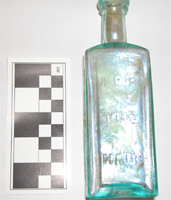Welcome, dear readers, my name is Megan Kane. I am a senior/master’s student in the Archaeology Center at Stanford. Having studied primarily prehistory for the last three and a half years, I thought it would be very interesting to learn about more historical archaeology, so I find myself taking CASA 203. I must confess that I never cease to be amazed by the level of detail that historical archaeologists can achieve in their studies. The kind of resolution we prehistorians rarely even dream of! Outside of my growing jealousy, I am learning a great deal about the process of cataloging and analyzing artifacts in the lab. Our time in the lab this week was split between two tasks: learning about lithics and small finds and searching for the artifacts that we will be working with in our projects. The topic of “Lithics and Small Finds” is a very broad one, and I found myself examining everything from prehistoric grinding stones, or manos, to opium pipe bowls. During lecture we discussed the various techniques employed in stone tool production, various striking methods for flaked lithics and how to identify production steps, later putting all of this to practice in the lab. The category of small finds includes many personal objects, like buttons, beads, pipes, etc. Having worked with period and vintage costuming in the past, I was particularly struck by the buttons we examined in the lab. It is amazing that, as an archaeologist, I can hold in my hand a small and a very personal part of someone’s life, like a shirt button or a pipe.
During the lab session on Friday, all of us began the mad scramble to find the artifacts that we will study in our research projects about the Market Street Chinatown. The lab table was quickly swamped as we searched catalogs, excavation reports and boxes for everything from toothbrushes and dolls to storage jars and glass bottles! My own research is focused on household and small scale religious practices in the Chinatown, a scarcely studied topic, and I am quickly discovering why this topic has rarely been touched on in previous studies of overseas Chinese communities! The types of religious practices performed in homes most likely included the burning of incense and food offerings to the gods and ghosts, activities which are either invisible archaeologically or indistinguishable from more secular activities. So it has been very hard to identify a class of objects in the Chinatown collection that might be associated with such practices. But I have stumbled upon several examples of oil lamps and candleholders, which might have been used during such household rituals. Now comes the arduous task of finding all the examples of these artifacts in the dozens and dozens of boxes and analyzing them!
Featured Artifact
This week’s artifact of the week is a small glass bottle that Stephanie is analyzing for her project. The bottle is aqua tinted glass, about 16.5 cm tall, embossed with “Lyon’s / Kathairon / For the Hair / New York.” The bottle is perfectly intact with a none too subtle proclamation of its original contents, a hair tonic. According to a period advertisement (see image), Lyon’s Kathairon was meant do just about everything, to cure baldness, to curl hair, to calm the scalp, and to reduce dandruff! This little bottle is a window not only into hair care and personal hygiene in the Market Street Chinatown, it might also reveal information about the ideals of personal appearance and the use of Anglo products by the Chinese overseas community.



